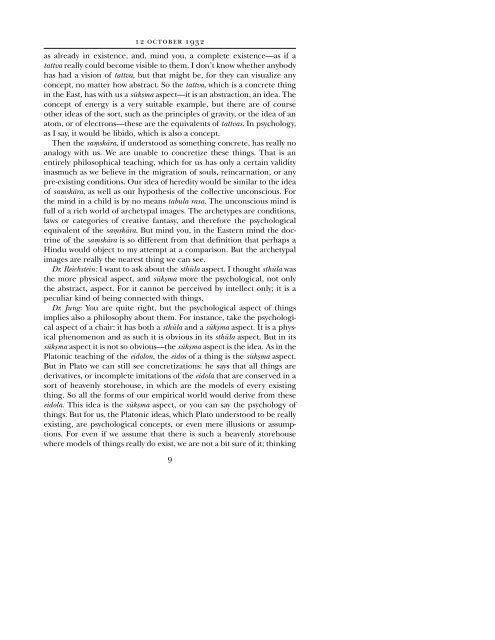CG JUNG - Countryside Anarchist
CG JUNG - Countryside Anarchist
CG JUNG - Countryside Anarchist
Create successful ePaper yourself
Turn your PDF publications into a flip-book with our unique Google optimized e-Paper software.
12 OCTOBER 1932<br />
as already in existence, and, mind you, a complete existence—as if a<br />
tattva really could become visible to them. I don’t know whether anybody<br />
has had a vision of tattva, but that might be, for they can visualize any<br />
concept, no matter how abstract. So the tattva, which is a concrete thing<br />
in the East, has with us a sÖküma aspect—it is an abstraction, an idea. The<br />
concept of energy is a very suitable example, but there are of course<br />
other ideas of the sort, such as the principles of gravity, or the idea of an<br />
atom, or of electrons—these are the equivalents of tattvas. In psychology,<br />
as I say, it would be libido, which is also a concept.<br />
Then the saôskvra, if understood as something concrete, has really no<br />
analogy with us. We are unable to concretize these things. That is an<br />
entirely philosophical teaching, which for us has only a certain validity<br />
inasmuch as we believe in the migration of souls, reincarnation, or any<br />
pre-existing conditions. Our idea of heredity would be similar to the idea<br />
of saôskvra, as well as our hypothesis of the collective unconscious. For<br />
the mind in a child is by no means tabula rasa. The unconscious mind is<br />
full of a rich world of archetypal images. The archetypes are conditions,<br />
laws or categories of creative fantasy, and therefore the psychological<br />
equivalent of the saôskvra. But mind you, in the Eastern mind the doctrine<br />
of the saôskvra is so different from that definition that perhaps a<br />
Hindu would object to my attempt at a comparison. But the archetypal<br />
images are really the nearest thing we can see.<br />
Dr. Reichstein: I want to ask about the sthÖla aspect. I thought sthÖla was<br />
the more physical aspect, and sÖküma more the psychological, not only<br />
the abstract, aspect. For it cannot be perceived by intellect only; it is a<br />
peculiar kind of being connected with things.<br />
Dr. Jung: You are quite right, but the psychological aspect of things<br />
implies also a philosophy about them. For instance, take the psychological<br />
aspect of a chair: it has both a sthÖla and a sÖküma aspect. It is a physical<br />
phenomenon and as such it is obvious in its sthÖla aspect. But in its<br />
sÖküma aspect it is not so obvious—the sÖküma aspect is the idea. As in the<br />
Platonic teaching of the eidolon, theeidos ofathingisthesÖküma aspect.<br />
But in Plato we can still see concretizations: he says that all things are<br />
derivatives, or incomplete imitations of the eidola that are conserved in a<br />
sort of heavenly storehouse, in which are the models of every existing<br />
thing. So all the forms of our empirical world would derive from these<br />
eidola. This idea is the sÖküma aspect, or you can say the psychology of<br />
things. But for us, the Platonic ideas, which Plato understood to be really<br />
existing, are psychological concepts, or even mere illusions or assumptions.<br />
For even if we assume that there is such a heavenly storehouse<br />
where models of things really do exist, we are not a bit sure of it; thinking<br />
9


